Learning how to draw a boat can open up a whole new world of creativity, whether you’re sketching simple canoes or trying your hand at more complex vessels like sailboats or fishing boats. With a few basic techniques and a little practice, you can create realistic or imaginative boat drawings that capture the spirit of life on the water. Drawing boats not only sharpens your artistic skills but also helps you appreciate the different forms and purposes that boats serve in art.
You’ll find that boat drawing can suit a wide range of artistic styles and traditions, from quick pencil sketches to detailed watercolor paintings. Many artists enjoy experimenting with different perspectives and locations, which can be inspired by real-life places or your own imagination. Whether you’re a beginner looking for step-by-step guidance or an experienced artist exploring new themes, working with boats as a subject offers endless opportunities to grow and express yourself.
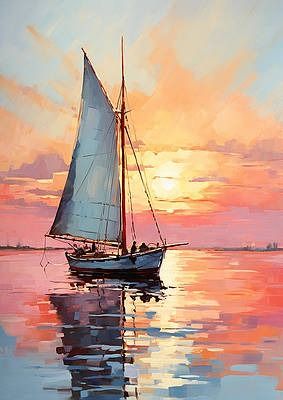


Key Takeaways
- Learn the basics to start drawing boats easily
- Explore different styles and creative approaches
- Drawing boats helps you develop new artistic skills
Fundamentals of Boat Drawing
A successful boat drawing starts with proper tools, a clear understanding of boat structure, and an eye for the essential forms that compose the vessel. To create accurate and appealing illustrations, pay close attention to detail in the construction and shape of both traditional and modern boats.
Essential Supplies and Materials
Begin with a smooth drawing surface. Sketching paper works well for pencil practice, but for more vibrant art, consider canvas or high gloss photopaper. Each medium affects how your lines and shading appear.
Pencils are ideal for initial sketches, but ink pens and fine liners help refine lines. Colored pencils and watercolors can highlight details such as metallic mirrors on modern boats or the texture of a wooden hull.
Rulers and erasers let you perfect angles and proportion. A soft eraser helps achieve clean highlights, especially on shiny surfaces like the bow or stern. For digital illustration, tablets and styluses provide flexibility with tools and layering.
If you want to mimic actual materials, experiment with mixed media—layer graphite for structural lines, then add watercolor washes to represent the water line or canvas sails. Try using metallic pens for reflective areas to create a convincing appearance.
Understanding Boat Anatomy
Understanding the architecture of a boat is critical for a realistic drawing. Boats have specific parts: the bow (front), stern (rear), hull (main body), water line, and deck.
The bow cuts through the water and usually sits above the water line. It often has a distinctive curve or angle that defines the boat’s profile. The stern is where the boat tapers off or flattens, and its shape can vary depending on the vessel’s type.
Pay close attention to where the deck sits relative to the hull, as this helps anchor the boat visually. The water line indicates how much of the boat remains submerged and adds realism. Sails and canopies crafted from canvas often adorn smaller boats, while metallic mirrors may appear on modern structures or navigation equipment.
Accurately identifying and drawing these parts helps avoid common mistakes and results in a more believable boat.
Basic Shapes and Proportions
Most boats can be broken down into basic geometric shapes. Start by sketching an elongated oval or rectangle for the hull, keeping proportions in mind. The hull is usually longer than it is wide, and its curvature changes depending on the type of boat.
The bow often narrows to a point or gentle curve at the front, while the stern may be more squared or rounded. To place the deck, draw a line parallel or gently arched above the hull’s upper edge. This line sets where the interior and exterior separate.
Use light guide lines to mark the water line. If your boat has additional features, like sails or a canopy, position them above the deck using simple triangles or rectangles at first, adjusting for the proper angle.
A table can help keep track of typical boat proportions:
| Part | Typical Proportion | Notes |
|---|---|---|
| Hull | 3-5x longer than wide | Adjust for boat type |
| Bow | Pointed or curved | Higher than stern |
| Stern | Rounded or flat | Can vary by design |
| Water line | Lower third of hull | Curves with hull shape |
Focusing on these shapes ensures that your drawing starts with strong, accurate foundations.
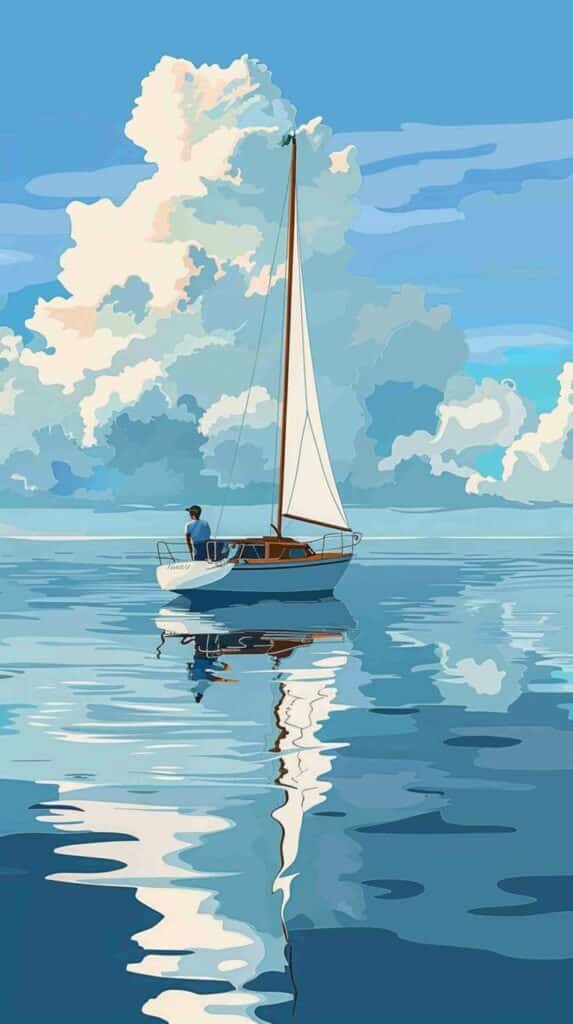
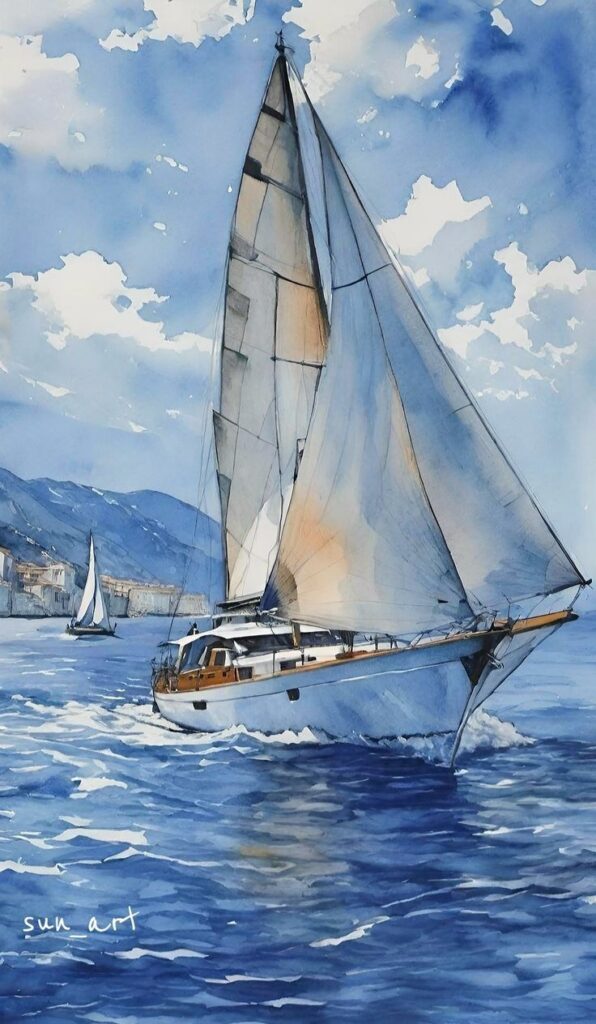
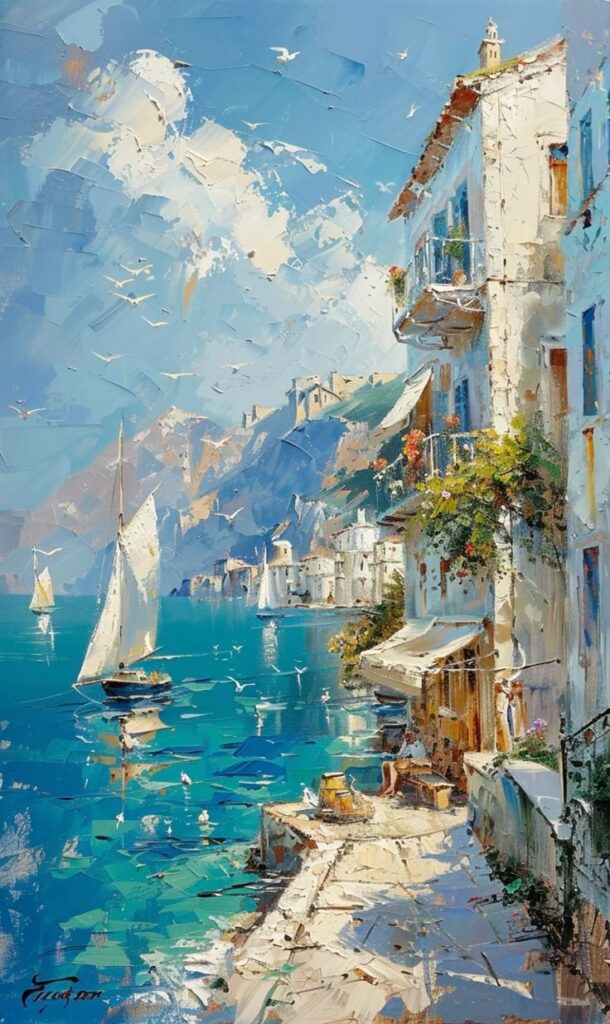
Step-by-Step Guide to Drawing Boats
Drawing a realistic boat combines careful outlining, adding essential textures, and integrating the boat into its surrounding landscape and water. With focused observation and a few arts and crafts basics, you can make all artwork more inspirational and detailed.
Sketching the Boat Outline
Start your boat drawing by lightly sketching the main shape using simple lines and geometric forms. Boats typically involve a long oval or figure eight shape for the hull, giving you a foundation to build on.
Use a straight line for the center axis to help keep proportions accurate. Sketch the deck, sides, and front (bow) with gentle curves. Keep your initial lines faint so you can erase and adjust as needed.
Add guidance lines for the mast or other visible equipment if you’re drawing a sailboat. For rowboats, sketch in seats or thwarts. Focusing on the basic silhouette first will help everything look balanced later.
Adding Details and Textures
Once your outline is set, switch to refining edges and introducing details. Begin darkening the main hull lines and carefully draw features like planks, windows, ropes, or railings.
Incorporate different pencil strokes and shading to suggest wood grain, metallic surfaces, or worn paint. Use short, repetitive strokes to simulate natural boat textures. For sectioned boats, draw parallel lines to indicate planks or create a sense of structure.
Pay attention to small details that make boats unique, like flags, lifebuoys, or registration numbers. These personal touches add character and make your drawing more engaging.
Incorporating Landscape and Water
Boats feel most authentic when placed in a fitting environment. Lightly sketch the waterline where the hull meets the water, making sure the reflection matches the boat’s basic shape.
To suggest gentle ripples, use horizontal wavy lines around the hull. For a calm lake, keep strokes soft; for ocean scenes, add broader, layered lines. Draw background elements such as trees, docks, or distant boats for added depth.
Consider adding subtle shading beneath the boat to create the illusion of weight and movement. Including nearby landscape details, like reeds or rocks, helps ground your scene and make it feel complete.
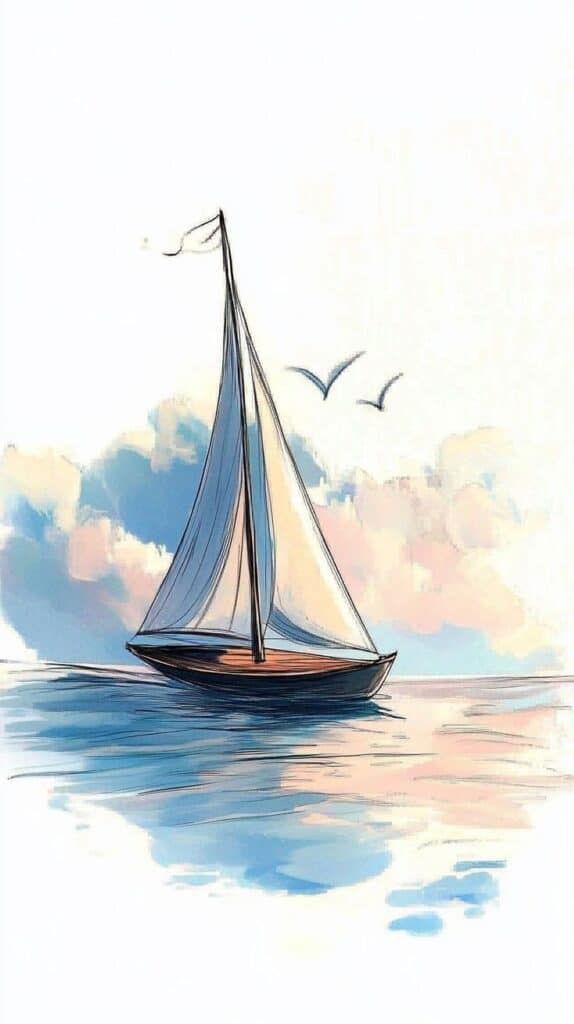

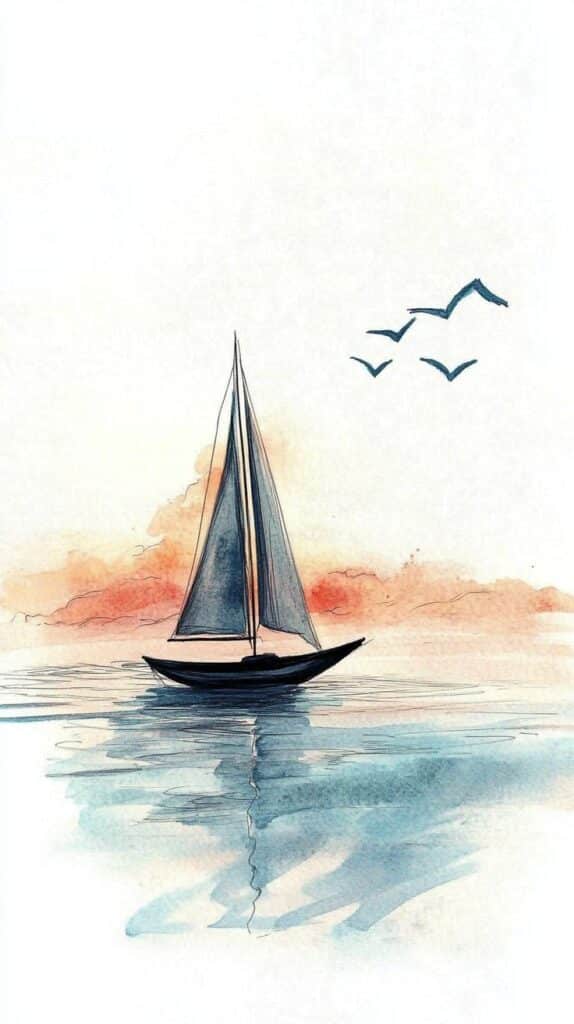
Styles and Themes in Boat Artwork
Boat artwork reflects a wide range of techniques and cultural expressions, from classic representations to playful or regional styles. The ways artists capture boats in their drawings often depend on their chosen methods, influences, and creative visions.
Traditional vs. Modern Techniques
When you look at traditional boat drawings, you often find precise lines and careful attention to detail. Artists working in the traditional style use techniques such as ink, watercolor, and graphite, focusing on accurate renderings, like those seen in classic Americana or European scenes.
Modern approaches take a more experimental path. Pop art and digital illustration tend to use bold shapes, bright colors, and stylized forms. With software and graphic tablets, you can create dynamic effects and explore abstract or minimal representations without leaving behind vintage inspirations.
You may notice that some drawings blend both worlds. For example, adding digital color over hand-drawn sketches merges old and new. This mix often leads to fresh, innovative results that still respect traditional forms.
Global and Regional Inspirations
Boat drawings are shaped by diverse global influences. European artists might focus on sailing ships in stormy seas, using moody tones and attention to historic vessels. Asian expression, especially from Japan and China, can feature delicate lines, flat perspectives, and nature-infused backgrounds.
If you enjoy Americana, you’ll see fishing vessels or riverboats drawn with rustic textures and a sense of nostalgia. Artists from coastal Africa or Southeast Asia may depict small wooden boats, exploring everyday scenes or ceremonial uses.
Here is a quick list of regional influences:
- European: Focus on historic vessels, stormy seascapes
- Asian: Delicate lines, emphasis on harmony, stylized waves
- Americana: Rustic, vintage, working boats
- African & Southeast Asian: Day-to-day river or sea boats, local cultures
Whimsical and Figurative Approaches
Not all boat art is realistic. Whimsical styles use exaggerated or cartoon-like elements to evoke feelings of adventure and fun. You might see boats with oversized sails or bright, imaginative color schemes reminiscent of children’s illustrations.
Figurative approaches can merge boats with symbolic or playful themes. For example, an artist might personify a boat or create fantasy scenarios with pirates, mermaids, or anthropomorphic ship characters. This style appeals to the young at heart and encourages creative storytelling.
When you explore this art, expect freedom in color, form, and perspective. The focus is less on accuracy and more on creativity, mood, and sometimes humor.
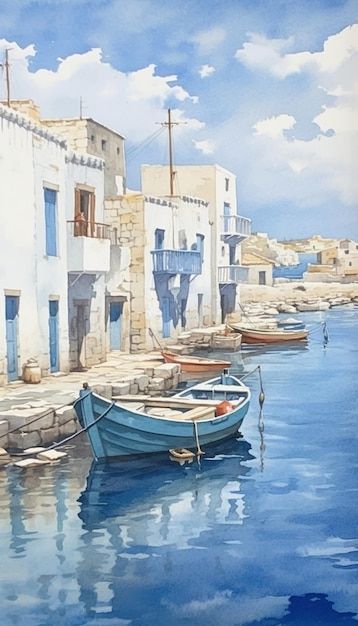


Geographically-Inspired Boat Drawings
Geographically-specific boat drawings offer insight into the rich variety of vessels and waterways found around the world. When you focus on real locations, your artwork reflects not just boats, but also culture, environment, and unique regional design.
American Coastal and Inland Scenes
If you’re interested in drawing scenes set in the United States, you’ll find plenty of inspiration along its dramatic coasts and wide rivers. In the northeast, New England states are known for their classic lobster boats and busy harbors, which are often drawn with sturdy hulls and weathered wood textures.
Maryland and the Chesapeake Bay area are famous for skipjacks and classic workboats. You might sketch these with long, elegant lines, sails, and crab traps on deck. Texas and the Southwest add another layer, with flat-bottomed boats and airboats suited to shallow waters, especially near city limits or in wild marshes.
For inland inspiration, American riverboats—especially paddle steamers on the Mississippi—make great subjects, often surrounded by scenic geography or bustling docks. Including regional landscape details, such as forested riverbanks, can help your drawings feel true to their locations.
European Waterways and Boats
Europe’s rivers and lakes are filled with boats shaped by centuries of changing needs and landscapes. If you draw a Venetian canal, focus on sleek gondolas gliding past historical city limits; their curved ends and decorative elements make them easy to recognize.
In the Netherlands and Germany, canal boats are often boxier and used for both transport and living spaces. Adding background elements like brick warehouses or narrow bridges gives context and depth to your drawings. You can also explore France’s river barges and England’s narrowboats, both shaped for specific waterways and regional geography.
Your sketches could include details from geography maps, such as winding rivers, city outlines, or harbor shapes. Regional weather, like fog on the Thames or sun on the Seine, further influences how boats look and move in your scene.
Other Global Locations
Beyond North America and Europe, boats adapt to every environment. In Canada, canoes and kayaks play a central role, especially in the lakes and forests. Traditional log boats, which you can find in search result images, are a common sight in many parts of the world, particularly in areas with abundant trees and calm rivers.
Asian riverboats, such as sampans and junks, have distinct silhouettes and decorative touches shaped by centuries of local use. In tropical regions, dugout boats or brightly colored fishing vessels are common, often set against vivid landscapes and contrasting with local geography.
Drawing boats from a range of locations lets you explore differences in design, purpose, and environment. Paying close attention to regional details—like construction materials, size, and the presence of specific gear—will help your drawings reflect the true character of each place.
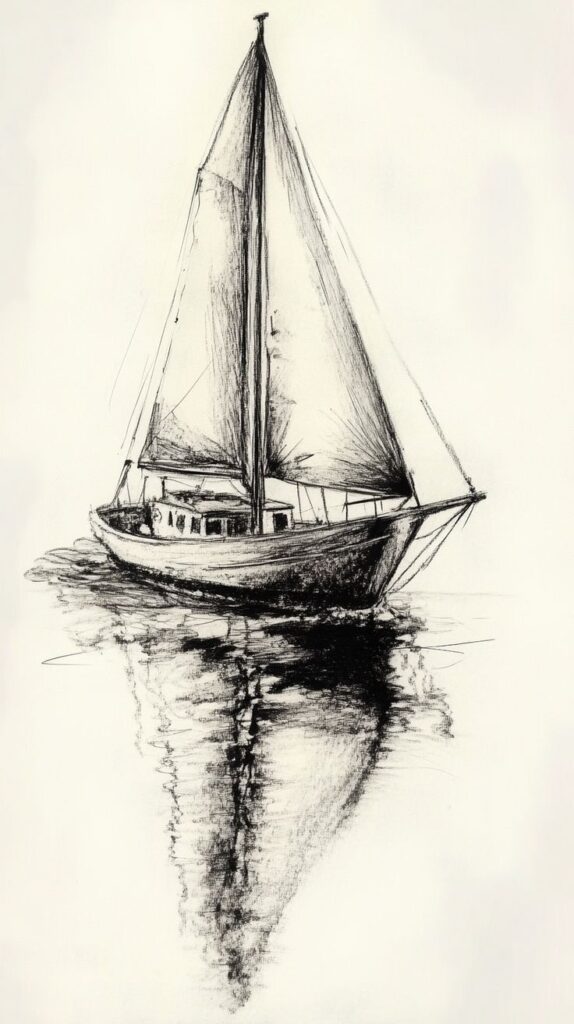
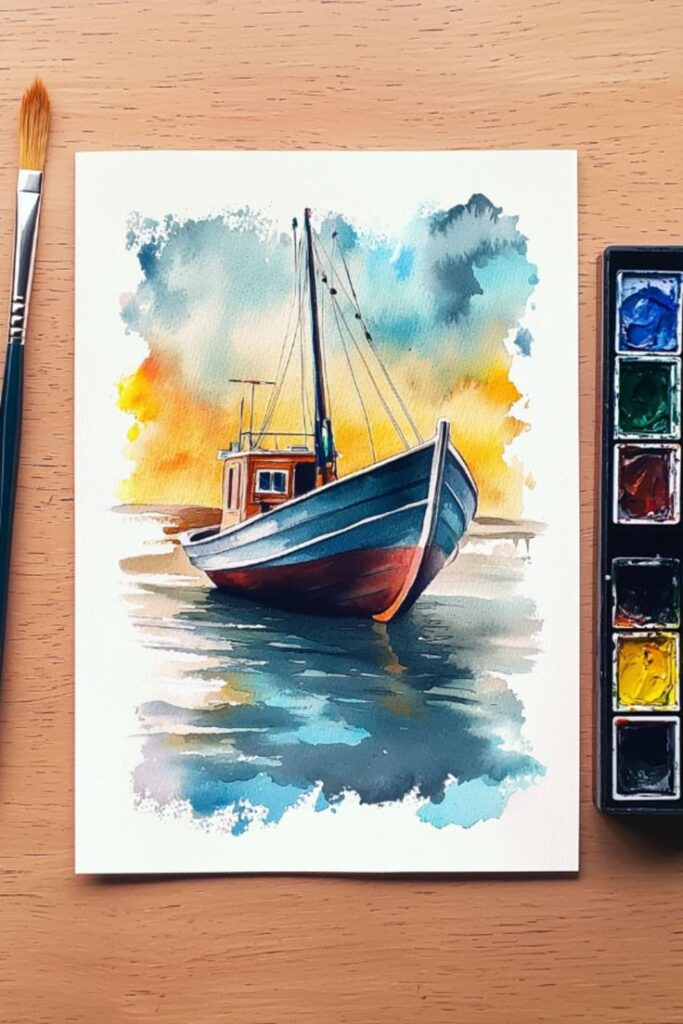
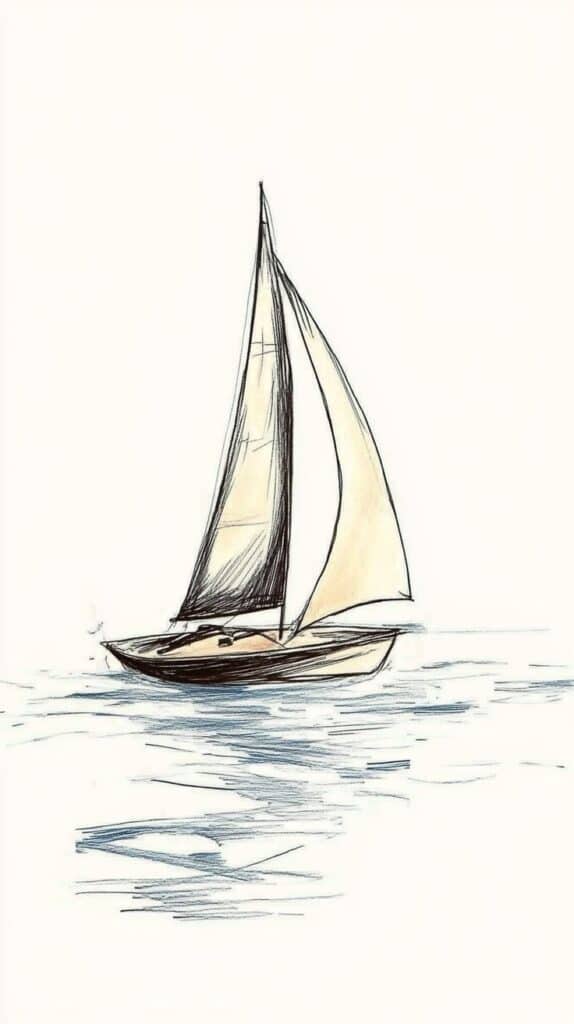
Boat Drawing in the Art World
Boat drawing has inspired artists across centuries and styles. From gallery exhibitions to fine art collections, boats offer artists rich subjects and a variety of moods, often reflecting journeys, environments, and the passage of time.
Influential Artists and Art Movements
Throughout history, boats have appeared in work by both famous names and contemporary artists. John James Audubon, best known for Audubon’s Birds and Quadrupeds, often depicted boats in scenes that highlighted natural settings, seamlessly blending wildlife and watercraft.
In more recent years, artists like Martha Spak and Nancy Sharpe have used boats in their compositions to capture tranquil and evocative waterside scenes. Their works are known for soft color palettes and peaceful themes. Photographers such as Richard Sherman also focus on boats, conveying movement and atmosphere through photography instead of paint.
Some modern painters—like Kate Mancini and Valentino Bustos—draw inspiration from coastal life, adding texture and energy to boat-themed pieces. These approaches show you how boats continue to evolve as powerful motifs in art. They appear not only as objects but as carriers of stories, culture, and identity.
Boat Art in Museums and Galleries
When you visit art museums, it’s not uncommon to see boats featured among their masterpieces. Maritime scenes from the 19th and 20th centuries, for example, often occupy entire rooms in coastal or large city galleries.
Special exhibitions feature painters who embrace nautical or seascape themes. Galleries like Martha Spak Fine Art showcase contemporary works centered on serene harbors and rowboats. Some photographers, such as Richard Sherman, display striking black-and-white images emphasizing texture and detail, while Kate Mancini Art offers vibrant, abstract boat scenes.
Many galleries maintain a permanent collection featuring boats “by the sea,” reinforcing this subject’s cultural and emotional appeal. When you explore these spaces, you see boats presented in realism, impressionism, and abstraction, highlighting their versatility and enduring charm.
- 1.5Kshares
- Facebook0
- Pinterest1.5K
- Twitter0


